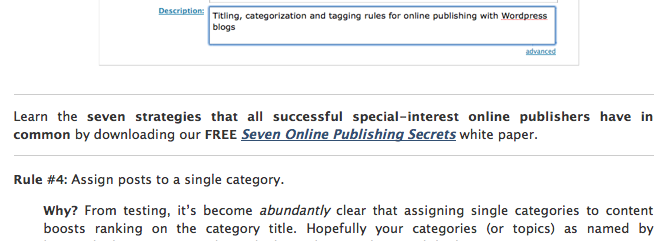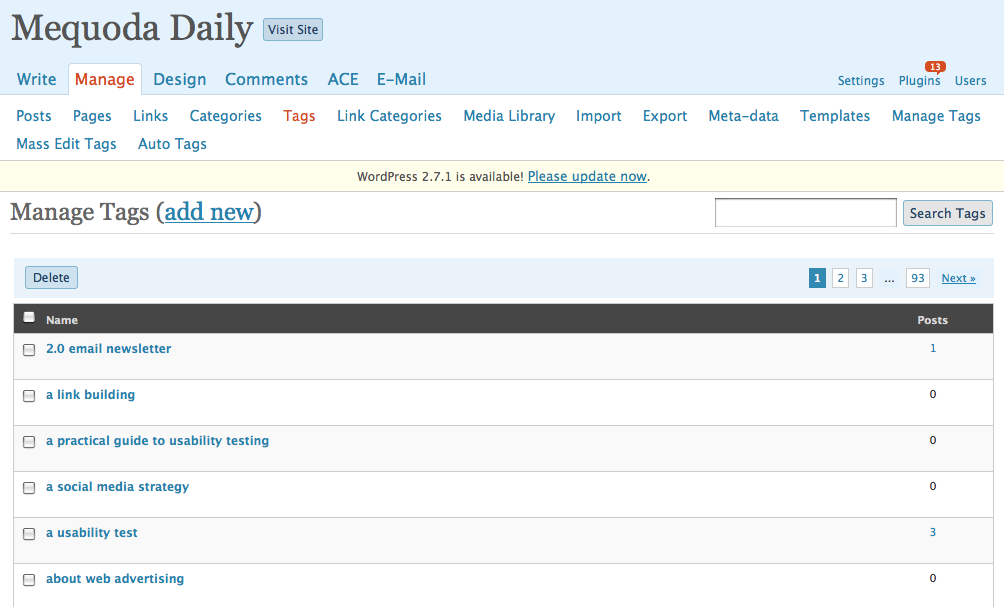Titling, categorization and tagging rules for online publishing with WordPress blogs
 When publishers pull apart their archived content and start putting it up on their blog, they have a variety of style options to choose from when posting.
When publishers pull apart their archived content and start putting it up on their blog, they have a variety of style options to choose from when posting.
We recommend taking a little extra time to optimize your old articles (whether they are evergreen or not) in order to make that content as valuable to your blog (and audience) as possible.
The following style guide for unleashing your print archives into a blog is specific to WordPress in terms of folksonomy, but can be applied to any type of blogging platform.
Rule #1: Include at least one primary or secondary keyword phrase in your blog titles and subhead.
Why? Because blog titles are so specific, you might choose to use a secondary keyword in your title (like “repurposed content” in the case of this blog) and a primary in your subhead (like “online publishing”). If you want to get ranked on a keyword in search engines (and you do), this is your prime real estate to display them. Read more on keyword research for blog titles…
Rule #2: Make sure your blog is set up to define your title and subhead in H tags.
Why? H1, H2 and H3 are highly regarded by Google as defining what a page is “about”.
Rule #3: Use a plugin like HeadSpace to gain control over the meta description of your articles and make sure you include atleast one primary or secondary keyword in there as well.
Why? If you aren’t able to write your own meta title or description, search engines will decide what to use on their own. What they choose is not always what you’d like to show up.
[text_ad]
Rule #4: Assign posts to a single category.
Why? From testing, it’s become abundantly clear that assigning single categories to articles boosts ranking on the category title. Hopefully your categories (or topics) are named as keywords that you want to be ranked on. This can also avoid duplicate content.
Rule #5: Include a text ad (using an ad server or a simple PHP call) in every post that links to free product.
Why? This is just another way to increase your website conversion rate. A no-risk offer like a free product is perfect for turning website visitors into email subscribers. Set up text ads to display relevant offers, rather than generic ones.
Rule #6: Load your entire keyword universe as WordPress tags, and assign all applicable tags to your posts.
Why? This shows Google what keywords your article is targeting, but more importantly, it helps you stay on track for optimizing the article at hand.
Rule #7: Assign an author to every post (and make sure your author pages are set up to promote your free products and maximize website conversion rates).
Why? The content you’re loading already has assigned authors, so this enables you to follow the same format. It also helps readers develop a relationship with your writers, rather than having a global voice. Depending on your brand strategy, you might skip this rule.
Rule #8: Slip keywords into image “alt” tags and names.
Why? This method will get your ranked in Google images, as well as offering your articles and pages one more place to score a keyword mention.
What’s your style guide for for taking years of old content and repurposing it into a robust Internet hub?







This site gives away sample submissions and delivers a full seo report for your website,
sales page: Search engine submission service
free submission and report page: free seo report
Hi Rob,
I recognized your name and happen to remember that you operate a paid membership website, so I thought I’d chime in. Most of what you’re publishing behind your paid firewall isn’t being seen by the search engines, so I think in your case, it’s Ok to keep doing what you’re doing for your members’ benefit.
If you ever decide to publish a free companion site to CreditToday.net, where you’d be posting articles in full for free (perhaps older archived content?), then we would recommend applying the discipline of posting each article in only one category.
Hope this makes sense!
Best,
Kim
Hi Rob,
We only just figured this one out. Our primary keyword at all times is Online Publishing, so we’re constantly watching our rank on that term. We originally were doing what you’re doing, which is applying articles to as many categories as we thought they could fall into.
But a couple of times, we posted articles, only using “Online Publishing” as the category (simply because they didn’t apply to another one), and suddenly we were ranked on Online Publishing with that article.
So, we started putting articles in one single category, and suddenly they were all getting picked up on their designated term.
I think what we learned is that we’re “spreading out” our results by assigning posts to every category it could possibly apply to. By being more focused, we’re getting much better rankings, where before we wouldn’t rank at all.
Now we’re working on making sure we have more specific categories so that it’s still user-friendly but also working for us in terms of SEO. 🙂
Remember, you can also use tags to define your content too, and as far as we can tell, you can assign as many tags as you want and it doesn’t dilute the results.
Amanda,
As always, an interesting and worthwhile read. I have a question regarding your rule #4:
>> Rule #4: Assign posts to a single category.
Why? From testing, it’s become abundantly clear that assigning single categories to articles boosts ranking on the category title. Hopefully your categories (or topics) are named as keywords that you want to be ranked on. This can also avoid duplicate content. >>
I want to make sure I understand this correctly. On our site, our articles are organized into what we refer to as “departments,” perhaps (though I’m not sure) the same as what you refer to as “categories.”
When we have an article that might be useful in multiple departments, we “clone” it into all of them, so it can be found by our users in various places on our site.
Does this practice hurt you with the search engines?
We’ve done it to be more user-friendly with our members, but maybe it’s counterproductive.
Thanks,
Rob
Simple yet effective way to bring old posts to life. I use SEO extensions.. Dont know how effective they are 🙂